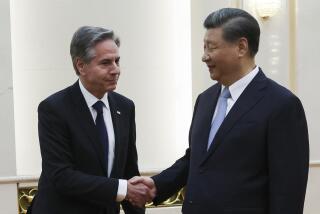Pork Rationing Casts Shadow on Effectiveness of Reforms in China : Country Returns to Subsidies When Supply Is Short
- Share via
BEIJING — Guo Heiran was delighted to see a rationing announcement go up not long ago at the pork counter in the Chaoyangmennei market.
“This illustrates the advantages of socialism,” said Guo, 64, a retired school administrator who had come to the market in a blue Mao suit and cap.
“Here it’s not as it is in some countries, where, when there’s a shortage of meat, people with money can buy it and poor people can’t,” he said. “People are equal. Those who earn more money have meat to eat. Those who earn less money also have meat to eat.”
A couple of young men, less convinced of the advantages of socialism, overheard Guo’s remarks.
“Old revolutionary,” one muttered.
“Silly old jerk,” said the other.
The reappearance on Dec. 1 of pork rationing in Beijing--in seeming conflict with general trends toward improved food supplies and greater reliance on market forces--has been received with mixed feelings by consumers.
Some are happy. Others find it an inconvenience and worry about its implications for the fate of China’s economic reforms.
But the resumption of pork rationing, last seen in Beijing for a few months in early 1985, is basically aimed at limiting public dissatisfaction over a temporary pork shortage while efforts are made to solve the problems that led to the shortfall in hog production.
It also illustrates the complexity of the problems faced by China’s reformist leaders as they seek to guide their nation onto a more market-oriented economic path. And it can even be seen as an indication that market cycles have arrived in China.
Rationing of pork, the principal meat in the Chinese diet, does not mean that consumers are limited to the monthly ration of 2.2 pounds per person available at subsidized prices in government stores.
Quantities Not Subsidized
It means that the government wants to ensure that everyone can get at least this much meat at a relatively low price, while purchases of larger quantities will not be subsidized. People who want more pork must pay its true cost.
Pork is readily available at peasant-run free markets in Beijing and other cities. At these, people pay a higher price in return for convenience and a choice of leaner cuts. Some state-run stores also sell meat beyond the ration, at a higher price.
Pork typically costs about 50% more in the free markets. At the government-run Chaoyangmennei market, fatty pork costs the equivalent of about 45 cents a pound, and lean pork, when available, about 60 cents. At a street market nearby, lean pork costs 85 cents a pound.
Per-capita consumption of pork in China has risen to 2.6 pounds a month in 1986 from 1.4 pounds a month in 1978, according to government statistics. But after years of growth, hog production declined this year by about 2.6%.
Two other major Chinese cities, Tianjin and Shanghai, also instituted pork rationing in recent weeks. Many other cities started such programs earlier in the year.
On Dec. 1, Beijing also instituted sugar rationing--2.2 pounds a month for families of three or smaller. Larger families get 3.3 pounds a month. Rationing of eggs--typical in Beijing in winter--began a bit earlier.
Grain Costs Cited
Because of pork’s central role in the Chinese diet and the symbolic importance of the capital city, it is Beijing’s pork rationing that has drawn the greatest attention. The press has tried to explain the situation to consumers in an effort to limit discontent.
“There is an essential difference between the rationing of today and that in the past,” the official People’s Daily said in a commentary. “In the past, rationing was a form of very limited allocation of scarce goods. Now, the government spends a lot to subsidize pork. The more pork people eat, the more subsidy they receive. If there is no limit on this, the government will hardly be able to shoulder the burden in the future.”
One of the basic causes of the problem, the newspaper said, is that the purchase price of pigs has been unreasonably low in relation to the cost of feed grain, and this “inevitably curbs the peasants’ enthusiasm to raise pigs.”
“The pork price should be raised,” it continued. “But the hundreds of millions of people of our country have been accustomed to the living style of low income and low expenses for so long that psychologically they can’t bear a sudden price change. Yet, to use subsidies to solve this problem is beyond the government’s resources.”
A Western diplomat commented that “the pressure is really high to not have price increases.”
“By having rationing,” the diplomat said, “they’re saying to consumers, ‘You can still get your cheap pork. But if you want to have more pork, or different (higher quality) pork, you need to pay more.’ Now the consumers can’t scream that prices are too high because the government can say, ‘You’ve got the coupons, you’ve got the rationing, you can get it.’ ”
The pork shortfall results largely from a boom-and-bust pattern that looks very much like a market cycle, although Chinese officials do not like to call it that.
The cycle began in 1984 with a bumper corn crop that provided large supplies of cheap feed grain. Together with policy changes intended to spur hog production, this led to a sharp increase in pork production.
Sows Slaughtered
This was followed by mediocre corn crops in 1985 and 1986, and increased sales of corn by China on the international market.
By 1986, corn supplies no longer met demand, and the feed price rose by roughly 40%. But there was only a much smaller increase in the price paid by the government for hogs.
“What happened in late 1986 was a lot of hog slaughter,” the diplomat said. “That means a lot of pork on the market, and the free market price of pork plummeted.”
By last winter, many disillusioned peasants even began selling their breeding sows for slaughter.
“That makes it difficult to get production going again,” the diplomat said.
Corrective measures began months ago. The government expanded a program of providing subsidized feed grain to peasants who agreed to sell hogs to the state. Also, less grain was exported; this year’s corn harvest was excellent, and the market price of feed grain began to come down.
Still, by autumn, pork was in short supply, and its free-market price was shooting up.
“Although the hog farmers were expanding their herds again, they weren’t old enough to slaughter,” the diplomat said. “Prices and inflation are so sensitive to the government right now that they didn’t want to ride it out--let the prices go wild for a while--with the idea that since the production situation has improved it would right itself.”
Government statistics published in August showed urban retail price inflation running at an annual rate of about 10%. Pork prices were up 17%. Prices of many other foods were up about 20%.
Another factor in the rationing decision was that the sale of cheap pork in government stores, combined with the existence of free markets where it sells for a higher price, created opportunities for middlemen to skim profits simply by buying up subsidized meat and reselling it.
This was reflected in a sign at the Chaoyangmennei market, which said that the purpose of the rationing was “to guarantee the pork supply and prevent pork from flowing out of the state-owned market.”
“Some peasants would buy pork here and sell it elsewhere in the free market,” one of the butchers complained. “Some could make 50 or 60 yuan (about $15) a day.”
Tianjin faced severe pork shortages from June through August, even though the city was procuring 24% more pork than it had in the same period the previous year, because “there were people who purchased large quantities of pork (in Tianjin) and had it transported to other places and resold at a higher price,” the Economic Daily reported in early December.
But the official position is that all these problems should be solved by improved use of market mechanisms, not a return to tighter control.
“The current instability in the pork market is to some degree related to new problems encountered in the course of reform,” the People’s Daily commentary said. “But to solve problems encountered in reform, the basic method is to unflinchingly press on with more reforms.”
More to Read
Sign up for Essential California
The most important California stories and recommendations in your inbox every morning.
You may occasionally receive promotional content from the Los Angeles Times.










